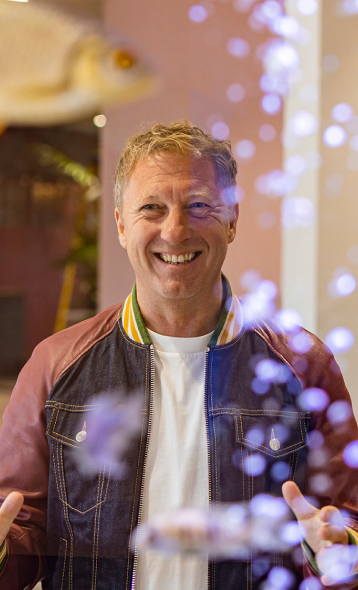DIGITAL WAYS OF WORKING. ONCE, A CHOICE. NOW, THE ONLY OPTION FOR MANY INDUSTRIES. INCLUDING OURS.
Your team’s transition from the physical place to the digital space is made possible by tech. But it’s your ability to embrace new behaviours and a new mindset that will determine just how productive, collaborative and smooth that journey and your digital destination are.
We went through a digital transformation of our own not too long ago. So, we thought we’d share what we learnt, in the hope that you’ll take something away that turns yours into a roaring success.
FIRST, WE CHECKED OURSELVES
The platforms we were using before weren’t quite cutting it. Our people were drowning in a sea of emails. From important client messages, all the way through to all-users about free cake. Our inboxes were bloated. There was no sense of digital community – just faceless emails going to and fro – with no chance for wider interaction.
Collaborating on documents was a sticky process too. With different versions existing in different inboxes, it was hard to know if you were working on the latest copy. And the ability to edit a document together in real time just wasn’t there.
We were using Skype, so we had video calling tech, but it wasn’t being used nearly enough considering our flexible working policy. Working remotely felt clunky. Our apps and calendars felt disconnected. And there was no slickness.
SO, WE STARTED TO DREAM
And we asked ourselves how we wanted our digital culture and ways of working to look and feel going forward.
We were growing. Fast. And with our people and our clients dotted around in more and more locations across the UK and overseas, we wanted a platform that would keep us all connected – with no compromise to the all-important ‘human feel’ – wherever we may be.
We wanted it to be secure and easily accessible on all devices. And we wanted to use it to streamline everything we do, saving us (and our clients) time and money, and future-proofing our business.
But, above all, we wanted our people to enjoy using it. We wanted to engage everyone at CP; from traditionalists to millennials and Gen-Z; from accountants to tech experts. And we wanted to show them that when we promised a truly flexible way of working, we meant it.
Because as we enter the post-pandemic world, however that may feel, we don’t want to go back to only attracting and retaining people who live within a commutable distance of our offices. We want to open our talent pool up to the most diverse, brightest, best people the world has to offer.
WE WEIGHED UP OUR OPTIONS
We found loads of different, powerful specialist tools out there. A lot of them would have been perfect for smaller teams, or a particular part of our business. But we needed a broad platform. One where all the elements worked with each other – and spoke to each other – seamlessly.
So, we chose Microsoft Teams. It ticked all our boxes; keeping us human in the digital age through high-quality audio and video calls; making internal and external project work and collaboration seamless; and ensuring none of our people or clients had to be in the room, to be in the know, with added extras like livestreaming capabilities, which we’ve been using to host events and webinars recently.
Teams has become our centralised hub for productivity and communication. But we’re not going to dwell on the tools and tech too much, because ultimately: they’re the base to your digital transformation pizza. The building blocks. They hold everything (and everyone) together. And they make your digital aspirations possible.
BUT YOU WANT SUBSTANCE
You want to feed your appetite for true, tangible change and impact. You want it to be a hit with your people. And you want fantastic value for money. For that, we’re gonna need toppings. And they come from carrying your culture over into the digital world, and using it to help your people adopt, learn and embrace these new ways of working.
Everything that’s great about any business comes down to one thing: people. The way they support each other. The way they push each other. And the feeling of community and belonging they create.
So, when we went from 6 offices across the UK, to 450+ ‘home offices’ overnight in Lockdown #1, losing the face-to-face, physical interactions that humans have built relationships with since the dawn of time, how could we replicate that ‘in it together’ feel virtually?
CREATING AN INCLUSIVE DIGITAL SPACE
We’ve created a channel called ‘The Common Room’ in Microsoft Teams. Similar to the physical common rooms in schools and colleges, it’s a space where everyone has a voice. We share all our internal news and updates there. And because Teams lets you ‘like’ posts, comment on them, or share your own, conversation and creativity flow through it – just as they would in one of our offices – but now, everyone’s together under one virtual roof. And they’re interacting with people from different teams and locations that they wouldn’t ordinarily have the chance to.
For us, and we suspect many of your businesses, the biggest shift we needed in culture and mindset was the realisation that tech isn’t a barrier to human interaction. It’s an enabler. And it gives us and our clients far more flexibility, because with the limitations of physical distance and train cancellations out of the equation, all it takes is a few clicks for us to talk to each other, share our knowledge, collaborate in real time, and produce awesome results.
Digital community is about taking the physical spaces and interactions our people and clients love – from the social areas and the yoga classes, to the meeting rooms and the seminars – and making them virtual. That’s how you get adoption and usage to go up. And as the fourth industrial revolution and its technological advances whistle on at fibre-optic speed, we’ve never been in a better position to make it happen.
GIVE TRUST. GET ENGAGEMENT
Digital ways of working put the trust between businesses and their people to the test. It’s not an elephant in the room. It’s natural. Because without the physical check-ins and chats we’re used to in an office environment, it can be hard to know how our people are getting on with certain tasks.
But remember: there’s no motivator quite like feeling trusted to get something done. So, with all our teams suddenly forced to work remotely, communication is everything. But it has to be the right kind.
Regular feedback is the backbone to a successful digital shift. And we need to connect with our people and find out how they’re feeling as often as possible. But when it comes to tasks and projects, we need to set goals, deadlines and outputs. Without prescribing guidelines on how to get there.
Because ultimately, digital work is flexible work. In every sense. And that mindset is more important than ever right now, because if our people are more productive when they’re enjoying the sun with their kids for an hour or two in the day, and working later at night – free from any distractions – that’s awesome. For everyone involved.
So, spend less time checking your team are working. And more time creating an environment that you’d want to produce your best work in.
NEVER STOP EVOLVING
Before COVID-19, our Microsoft Teams usage and adoption levels were good. But until we were hitting 100% across the business, we knew we could do better. Now, with this environment pushing those numbers sky-high, and some really positive feedback coming in from our clients, the challenge has changed.
How do we make sure these digital ways of working stick? Because we can’t look at this time as a short-term fix. It’s an opportunity to become a better version of what we were before. For our people. For our clients. And for everyone we’ll have the chance to work with when – not if – we become digital by default. Because that’s the future. We’re powerless to stop it. And with all the benefits it would bring, why would we even try?
So, our remote audit and tax work, webinars, livestreamed events and podcasts have had a great reception externally. And our virtual yoga, boot camp, pub quizzes, workshops and mindfulness tips have had the same reaction from our people.
But how much of that will continue when the country’s back on its feet? And now that digital ways of working are the norm, how do we continue to disrupt the market and wow our clients with a fresh experience?
They’re questions we’ve been thinking about a lot. But with every digital success resting on our people, we’re sure they hold the answers.




















